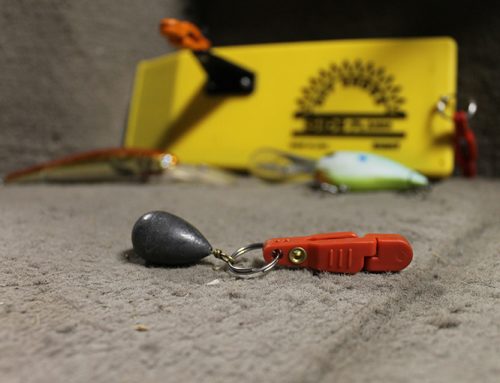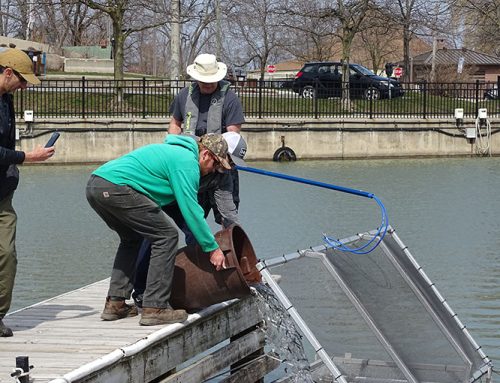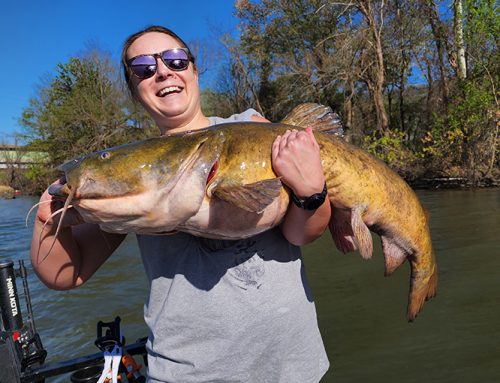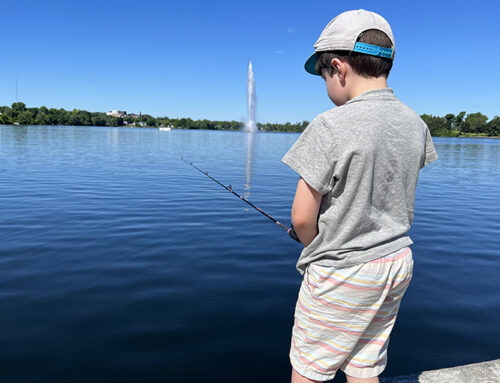
Somewhere among the sand and rocks a walleye has just decided to clamp its yap around a bladebait. It happens again a few casts later and continues for several more fish.
At certain times in spring, a jigged bladebait is tough to beat. Though, I’ve often wondered what prompts walleye, a highly evolved predator, to eat something as artificial as an all-metal bladebait? This is a complex question with many factors to consider, but I believe the lure’s sonic signals are part of the answer. This vibrating lure isn’t an anomaly, of course. Rattling minnowbaits, thumping boot-tail swimbaits, kicking spoons, and whirling spinner blade presentations all produce sounds and are reliable walleye offerings.
The following provides a mix of scientific and angler insights on how vibrations influence walleye as predators. Read on to learn how a fish’s acoustic senses work, along with recommendations from three angling experts on successful vibration-centric presentations for walleye.
Post-spawn melodies
Cameron Boake, a Pure Fishing ambassador from North Bay, catches walleye from shallow water on lipless crankbaits, rattling jerkbaits, and swimbaits from late May to early July on Lake Nipissing, Lake Temagami, and other area lakes. During this time, walleye transition away from spawning areas, but remain shallow and orient around points, rocky humps, and cabbage beds as they slowly make their way towards the basin where they’ll spend the summer.
“I find rattles are important when the bite is in dirty water, in windy conditions when there’s a lot of water movement around the bait, and during low light, helping fish key in on the bait,” Boake said. “Chances are there’s lots of food in these areas, too. Competing against shiners and other forage minnows, you want to have something that’s different and stands out a little bit. I find rattles can help separate your bait from a giant school of shiners.”
The tools
The loud rattling Berkley Warpig lipless crankbait is Boake’s preferred choice for aggressive walleye in dirty, turbid water conditions on Lake Nipissing. A straight retrieve is used over ultra skinny rock structures. In six to 12 feet, he prefers yo-yoing the crankbait, letting it hit bottom at the end of each fall. He notes flashy silver-blue or black-gold finishes get more bites during the day.
Boake also catches his fair share of walleye casttng rattling jerkbaits over shallow rock humps and emerging cabbage. He likes a Berkley Stunna for Nipissing’s murky conditions and a Berkley Hit Stick for the dawn and dusk bite in Lake Temagami’s clear waters. His most consistent results come from a moderate, pull-pause retrieve.
Aggressive, snaps have their place, though, for triggering walleye feeding aggressively.
When walleye are less active or uninterested in rattling hard-baits, Boake switches to a 3.3-inch Berkley PowerBait PowerSwimmer on 1⁄4-ounce head. After making a long cast and letting the lure reach bottom, he snaps the rod to make the swimbait dart up and get its tail kicking. Then, he slowly swims it back to the boat, letting it bounce and tick off the floor.
“The vibration off the tail and ribbed sides of this bait is more subtle and can get those slower fish to bite,” he said.
River resonances
“When I’m shallow and fishing weedlines, vibration is huge,” said Yannick Loranger, owner-operator of Ottawa River Guided Fishing based in Rockland. “I catch a lot of walleye on spinnerbaits. It’s not the norm for targeting walleye, but a 11⁄2-ounce spinnerbait puts big fish in the boat better than most live-bait presentations.”
Loranger likes the durability and the big double willowleaf blades of a Kicker Custom Lures spinnerbait for daytime tactics seeing him sift through shallow weedy flats and emerging weedlines where walleye lurk. He uses the heaviest weight he can get away with between 1⁄2- to 11⁄2 ounces, based the weed cover he’s fishing. The vibrations produced by the spinnerbait’s blades give walleye something to target using their acoustic senses in the river’s murky, sediment-rich water where visibility varies from one to five feet.
The trick is finding the right weed growth. “I’m always looking for weeds coming up halfway. If I can’t see weeds with my eyes but they’re on my sonar, I’m in the zone,” Loranger said. “There might be a couple clumps of cabbage coming up here and there, but I’m looking for stuff that’s fishable and not so thick the bait’s hooking vegetation every cast.”
Loranger retrieves the spinnerbait so it occasionally ticks the top of the vegetation. Trolling is also effective. With this method, pulling the rod forward two feet, then dropping it back changes vibrations and speed, triggering strikes.
In addition to spinnerbaits, Loranger finds shallow, weed-oriented walleye respond to the vibrations from a 1⁄2-ounce Jackall Deracoup Tail Spinner and a #3 Mepps inline spinner. The steady thump from a trolled willowleaf or Colorado worm harness weighted with a couple split shots is another potent shallow, murky-water presentation.
Open-water tricks
Captain Paul Powis, owner J&P Fishing Charters and Guide Services, offers further insights on the vibration factor for walleye. Unlike the shallow structures and weedy cover plied by Boake and Loranger, Powis’ trolling game unfolds in Lake Erie’s open-water abyss.
“We have no structure, it’s all about bait,” Powis said. “Most of what I’ve seen is that baitfish don’t like clear water when there’s no structure and nowhere to hide, so they look for coloured water.”
Murky, muddy, silty, or green-tea-tinged (his favourite) water attracts baitfish because it gives them a better sense of security from predators. Powis describes it as a game of hide and seek. If walleye can’t see the baitfish, they use their acoustic senses, along with smell, to find their prey.
Different factors
Powis agrees a presentation’s vibration profile can be an important factor but stipulates it’s only one of many elements influencing whether a walleye will bite or not. Others include lure profile, action, speed, colour, and the depth curve on diving lures.
“I will say all my best crankbaits have rattles in them. That’s proven,” the Shimano Pro said. “I think the sound more or less interests them. They know something’s going on and they get curious about what’s happening.”
Another fact is different lures produce their own sounds. When specific crankbaits in his trolling spread aren’t catching fish, they’re side-lined and another lure is given the opportunity to produce. As you’d expect Powis carries plenty of deep-diving crankbaits. The Freedom Tackle Ultra-Diver Minnow and Shad, Rapala Deep Tail Dancer, and Yaleye-Fish Hooligan are just a few from his collection.
Wolverine Tackle’s Silver Streak, Northern King’s NK 28, and Triple Threat’s trolling spoons also catch Powis loads of Erie walleye. No rattles here, though. Instead, Powis explains, the spoon’s kicking action and its turbulence give these lures their sonic appeal. Powis also acknowledges the vibration advantages from the whirling blade on a worm harness. With both spoons and harnesses, there’s also an appealing flashy action accompanying vibration, not to mention the smell and taste of a nightcrawler on the harness.
Powis also points out that adjusting trolling speed changes the vibration and the presentation of bait. The takeaway here, folks, is a lure’s acoustic properties are malleable and adjusting speed is a way to fine-tune its sound profile for better results.
Nails on the chalkboard
This will likely come as no surprise, but certain sounds turn walleye off. The tip of the iceberg on this topic may be how a sudden, loud noise from a boat in shallow water can startle walleye, causing them to lose interest in feeding or leave the spot.
Interestingly, in some scenarios a loud bait may be too much of a good thing, so to speak. My experience is sometimes lipless crankbaits and noisy, rattling minnowbaits don’t interest walleye in clear water. Boake also finds loud rattle baits aren’t as useful in clear conditions compared to murky water. Trust me, I’ve experimented. I’ve watched walleye snub different rattling hardbaits using Garmin’s Panoptix forward-facing sonar. Then cast a swimbait or a finesse plastic to the spot and caught fish. Take this with a grain of salt, however. I know anglers who incidentally hook big walleye chucking lipless cranks to weed edges for bass in clear water systems.
With this in mind, I encourage you to consider the wide spectrum of sounds and vibrations available from the many walleye baits on the market. In some instances, fish may respond best to a loud, hard groove, but there will be other times when toned-down sounds and weaker vibrations prove more effective at generating strikes.
Remember, a lure’s acoustic properties are only one piece of the puzzle. When figuring out the bite, anglers must consider how walleye use their other senses to size up presentations and decide whether or not to bite
Originally published in the May 2022 issue of Ontario OUT of DOORS






Leave A Comment